Interior Painting 101
As opposed to buying expensive new furniture, art, lamps and other accouterments, it is far easier and less expensive to consider interior painting.
Adding a new color is one of the easiest and most popular home DIY projects. Painting your walls is a quick way of giving a room an updated look and feel.
Home » All You Need to Know About Interior Painting [2019 Guide]
All You Need to Know About Interior Painting ---- [2021 Guide]
This Guide Contains:
Interior Painting
Perhaps the easiest and most popular home DIY is painting a room, and it’s easy to 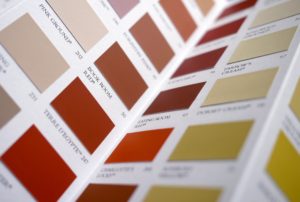 see why. Freshly painted walls are a quick way of giving a room an updated look. As opposed to switching up to more expensive and permanent parts of a room like a sofa or a wall cabinet, it’s easier and more affordable to paint a wall in a color that’s in trend.
see why. Freshly painted walls are a quick way of giving a room an updated look. As opposed to switching up to more expensive and permanent parts of a room like a sofa or a wall cabinet, it’s easier and more affordable to paint a wall in a color that’s in trend.
Painting is an easy DIY project taking up a day or two of most weekends, and with most paints and primers available in quick-dry formulas, any homeowner can do it. However, there are also interior painting companies who could lend you a helping hand in your painting project. How do you know when you need to employ the services of a painting contractor?
- Just moved in
When you just moved in, and you’re looking to paint all the rooms in your house, it might prove to be a huge task, especially if the house needs some repairs along the way.
- Too much preparation work
A lot of homeowners underestimate the amount of preparation needed for walls thinking that it starts and ends with slathering paint on the walls. If there are too many cracks, holes, and repairs to be done on the walls, consider getting the help of a professional painter whose scope of services include surface preparation.
- A requirement of special finishes
Some contractors specialize in special types of finishes meant for a specific type of material, and if you’re unsure whether you can do it yourself, then you might need some professional help.
- Not enough time
Painting may sound easy, but it may take up some of your time as well, and if you are not able to allocate time for painting you will be better off with getting the services of an expert.
Professionals to consider when painting:
- Color Consultant – A color consultant or expert can create color solutions for clients who are having a hard time picking out paint colors for their home. They use color psychology, theories as well as trends to come up with paint colors that are suitable for the home.
- Interior Designers and Decorators – Although they can help with color, they cater to an overall look and feel of the home and can help their clients pick out colors that will work and blend well with existing finishes and furnishings in the room.
- Interior Painting Companies- They are the ones who will do the actual painting job, and in case of bigger projects, they may have their in-house color consultants or partner with other professionals. The professionals working for the company know what type of paint to use and what type of finish is best suited for the look and purpose of the room. They also include wall preparation in their services.
Preparing Walls for Interior Painting
A lot of homeowners who prefer DIY underestimate the amount of preparation needed for wall painting. Not everyone is lucky to have clean, smooth walls that are ready for painting. Furthermore, if a house was built in 1978, there is a good chance that the paint contains lead and you need to take precautions to remove the paint safely.
Steps in Surface Preparation:
- Assuming that you’ve moved and covered all your furniture, taped what needs to be taped, protected your floors and unscrewed and covered all lighting fixtures, wires and electrical switch plates, proceed to cleaning your walls. A mixture of any household detergent with water will do the trick.
For kitchen and bathroom walls with grease or water stains, you may need to use stronger cleaning agents. Lookout also for mold and treat it with chlorine-based removers.
- Search for problem areas by carefully scanning the walls. A process called raking can help you find problem areas, which are not visible to the naked eye. It involves turning off the lights in a room, getting a trouble light and slowly running it across the wall to detect and mark small imperfections.
- Using a scraper, carefully scrape off all loose and chipped paint. It is a tedious part of wall preparation, so you need to scrape off only the peeled parts. In case the paint is still intact, leave it alone. Using a heating gun can help make it easier to remove old paint or wallpaper
- Fill and caulk seams, cracks, and holes. Joint compound is used for taping drywall seams together and for filling in small holes. Spackle, on the other hand, is used for small imperfections like cracks. Large holes in walls are remedied using self-adhesive aluminum patches and are covered with a compound afterward.
Depending on the existing look of the walls, you may need to skim your walls. Skim coating a wall is a texturing technique used by drywall makers, which involves applying mud to the existing wall to make the surface smoother and more leveled.
- Sand the areas putting extra focus on the parts where you applied fillers. Have an HPA vacuum on hand to get rid of dust. Take extra care if the old paint used is lead paint. You can find this out by getting a home lead test kit or sending a sample to centers to have it tested.
- Only apply primer if needed. For example, if your walls are heavily stained or if you are going to apply a lighter color to replace a darker one, you will need to apply primer. Otherwise, if your walls are clean or you’re simply repainting it with the same color you don’t need to use it.
- Start with painting trims, moving on to ceilings, leaving the walls last. Watch videos on how to effectively and efficiently paint a room to lessen or completely avoid mistakes.
How to Wash Interior Walls
Based on the types of finishes, the glossier the finish, the easier it is to clean. So, painting a room according to its use will help make maintenance simpler for you.  Dusting and vacuuming your walls weekly is a must before wiping it down with water. A simple sponge dipped in mild soapy water is what most paint manufacturers recommend to clean walls. For spot cleaning, a mixture of baking soda and water can be applied to the area before rinsing it with a sponge. For hard to remove grease-spots, use a dishwashing detergent, or get a special wall cleaning solution. Test out any cleaning solution on an inconspicuous part of the wall like behind a picture frame, before using it on the whole area.
Dusting and vacuuming your walls weekly is a must before wiping it down with water. A simple sponge dipped in mild soapy water is what most paint manufacturers recommend to clean walls. For spot cleaning, a mixture of baking soda and water can be applied to the area before rinsing it with a sponge. For hard to remove grease-spots, use a dishwashing detergent, or get a special wall cleaning solution. Test out any cleaning solution on an inconspicuous part of the wall like behind a picture frame, before using it on the whole area.
How Much Paint Do You Actually Need?
It’s common for homeowners to underbuy or overbuy paint, but this is avoidable with the right estimation. Most paint manufacturers indicate the estimated square footage a can of paint can cover. Once you know the coverage rate, you need to get 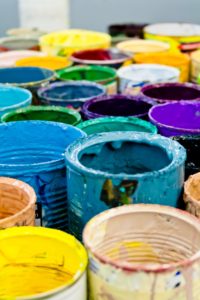 the area of the surface by multiplying the length by the width of the wall or ceiling. Simply add all the sides of the walls to get the total area. You then need to subtract the areas that are not going to be painted like windows and doors.
the area of the surface by multiplying the length by the width of the wall or ceiling. Simply add all the sides of the walls to get the total area. You then need to subtract the areas that are not going to be painted like windows and doors.
An example:
You want to paint an accent wall that measures 30 feet in width by 10 feet high with a door that’s 3 feet wide and 7 feet high. Your chosen paint indicates that a gallon can cover 350 square feet. By standard, you’ll be using two coats of paint on the wall so you’ll need to factor that into your calculations as well.
- Get the area by multiplying the width and height of the wall:
Wall Area = 30 feet (Width) x 10 feet (Height) = 300 square feet
- Get the door area and subtract it from the total square footage of the wall.
Door Area = 3 feet (Width) x 7 feet (Height) = 21 square feet
Total Wall Area = 300 square feet (Wall Area) – 21 square feet (Door Area) = 279 square feet
- Double the total area since you’re going to apply two coats of paint on the wall:
279 square feet (Total Wall Area) x 2 (Coat of paint) = 558 square feet
- Divide the total wall area by the estimated coverage rate of your paint. In our example, it’s 350 square feet so:
558 square feet (Total Wall Area) ÷ 350 square feet (paint coverage) = 1.59
Round off the result to the nearest whole number to get the required gallons of paint. In this case, you’ll need 2 gallons of paint. If you’re painting all four sides of the room, simply get the wall area of each side and add it together to get the total wall area. Most paint manufacturers also have a paint calculator on their website, but if you’re not confident with your calculations, you can take your measurements to your nearest paint store, and they’ll be happy to do the calculations for you.
Other factors you’ll have to consider is the color of the paint. If you’re using a darker hue, you may need several coats for your desired color to show through. Lighter paints may need to be painted on several times if the existing wall color is darker. Some surfaces are also more absorbent and may require more coats than usual. Higher quality paints are better pigmented and will give you a better-looking paint job.
How Long Will Interior Paint Last?
The longevity of the paint depends on three factors:
- The quality of paint.
Oil-based paints tend to last longer than water-based paints, but the downside is the amount of Volatile Organic Compounds (VOC) present in the paint. Higher quality paints also tend to be more expensive, so the price is a telling factor for the longevity of your paint.
- The paint job.
If your walls go through a proper preparation process before painting, you’ll have zero issues on cracks, holes, or peeling. This is why it’s just as important to do a proper surface preparation prior to painting. Most interior painting companies say that an excellent paint job will last a good five years.
- The amount of traffic that a room receives.
The traffic of the room strongly affects the longevity of paints. High traffic rooms are more prone to chipping, abrasions, and cracking. Some paints are highly abrasion resistant, and this is good if you have kids in your house.
Types of Interior Paint
Water-based Paint
Water-based paint is preferred nowadays by most interior painting companies and homeowners primarily because it is easy to use. It has low VOC, making it safer for both the user and the environment. It’s quick-drying, easy to clean, doesn’t fade easily and is not prone to mildew growth.
Oil-based Paint
Oil-based paints are more durable and pigmented, giving walls a richer color. The downside of most oil paints is that it has more VOCs and therefore emit stronger fumes. This type of paint is best for high-moisture rooms like kitchens and bathrooms where water can’t mix with oil.
Color Ideas
Choosing interior paint colors can be overwhelming for a lot of homeowners with all the available ideas and inspirations. If you can afford the services of color consultants and designers, they can guide you step-by-step on how to choose colors. Otherwise, you can do it yourself too. Interior Design Magazines and websites have plenty of ideas available, not to mention Pinterest as well as DIY blogs. Here are some tips that will help you to make the right choice:
- Ask yourself what mood you are trying to achieve in a room. Do you want something bright and cheery because you live in an area where winters are long? Do you find yourself leaning towards rooms that are dark and cozy? Whatever you choose, the mood you want your room to evoke will help you decide on a color.
- Look at your existing furniture, finishes, and accessories. Take pictures and create a mood board that will put these colors together and will create a cohesive look.
- If you’re looking to play it safe, neutral, and white wall colors are beautiful and timeless choices. Selecting a single accent wall while the rest of the room remains neutral is an easy and safe way to test out a trendy color rather than painting the whole room in a single hue.
- You may also base your choices on the texture of your walls. Lighter colors are more reflective than darker colors and tend to reveal imperfections while darker colors conceal flaws.
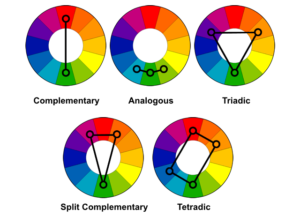
- The color chart or wheel is a tool that you can use to help you decide on color schemes. Red, blue, and yellow are the primary colors while orange, green, and violet are the secondary colors. The color wheel is separated into two parts: the warm colors exhibit brightness and energy while cool colors convey peace and calm.
- Complimentary – are two colors opposite of each other on the wheel like green and red.
- Analogous – are any three colors placed next to each other like orange, yellow, and green.
- Triadic – are three colors that are equally apart on the color wheel like violet, green, and orange.
- Split Complementary – are three colors using a base color and two colors adjacent to its complement. An example is green, orange, and violet.
- Monochromatic – are all the tints and shades of a single hue.
- Tetradic – are four colors using two sets of complementary colors. It forms a rectangle on the color wheel. An example is blue and violet paired with green and orange.
What is the best paint finish for walls?
There are always new colors in style every year, largely thanks to Pantone who releases a trendy new color annually as a guide for designers. However, rather than follow trends, most homeowners want something timeless because they know that trends don’t last forever.
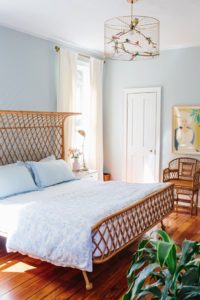 For living rooms, which is one of the major areas in the house, white remains to be a popular color choice even for those with children. It’s also easy to mix in different finishes with a white background. Other color palettes include gray walls paired with brighter furnishings like yellow or chartreuse, taupe walls with blue and green or blue and orange accents and beige walls paired with more vibrant accents.
For living rooms, which is one of the major areas in the house, white remains to be a popular color choice even for those with children. It’s also easy to mix in different finishes with a white background. Other color palettes include gray walls paired with brighter furnishings like yellow or chartreuse, taupe walls with blue and green or blue and orange accents and beige walls paired with more vibrant accents.
Darker and sultry color palettes are saved for bedrooms while cool, calm blues remain popular colors for both Master and Guest Bedrooms. Daring homeowners 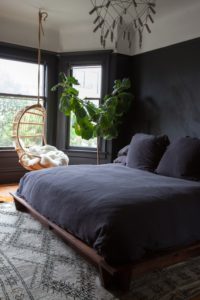 are using black as their wall colors for their rooms as well as dark forest greens and chocolate browns. For those who want a calm and relaxing environment for their room, can still opt for lighter shades of blue.
are using black as their wall colors for their rooms as well as dark forest greens and chocolate browns. For those who want a calm and relaxing environment for their room, can still opt for lighter shades of blue.
Contrasting colors prove to be popular, so if you’re going to paint your kitchen walls, look to your cabinets for inspiration. Chartreuse walls add a dash of zest to any kitchen and remains a well-loved kitchen color that compliments white and wooden cabinets. You can also add a splash of yellow using it on spaces between the lower and upper cabinets.

Types of Paint Finishes
When you have finally chosen your interior paint color, it’s time to settle on the type of wall finishes. Like color, finishes are make-or-break for any room.
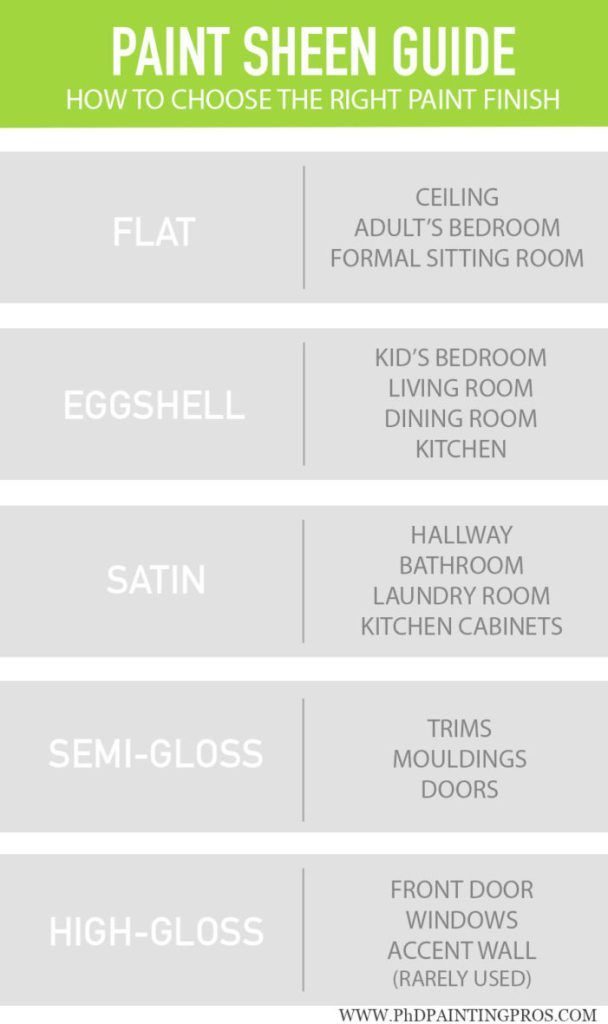
- Matte – Matte is often used to hide imperfections on walls and makes colors look rich. The downside of matte is that it’s difficult to clean and not for those with crayon-wielding children. Because of this, it is good for areas with less traffic. It is also often used for ceilings. This finish is often interchanged with Flat paint finish.
- Eggshell – This is the most commonly used finish for interior walls. It has subtle reflectivity than matte and is fairly easy to clean making it a versatile paint finish for any type of room.
- Satin – Some paint manufacturers and painters interchange this with Eggshell finish, while some say that satin finish is much more velvety and glossier than eggshell. So, make sure to ask the paint store the difference based on the paint manufacturer.
- Semi-gloss – Provides much more reflectivity than eggshell, this is commonly used for trims and areas where it tends to get drips, grease, and stains like kitchens. Painters advise using eggshell on walls while using semi-gloss for trims, baseboards and other architectural features to highlight it.
- High-gloss – This is the most reflective finish, highly durable and easy to clean. High-gloss finish is recommended for areas where sticky fingers are bound to touch like doors, cabinets, children’s rooms, and kitchens. Avoid using this if your wall has imperfections, as this finish will certainly highlight those problematic areas.
FAQs
What are the important steps before painting a wall?
In addition to surface preparation as discussed above, researching and sampling the paint colors is also very important. Take advantage of free paint chips, have it painted on a small part of your wall or get a wooden board and paint it with your desired color. Look at it in different lights: artificial, natural sunlight, and even at night. This is equally important, as you don’t want to regret your color choice when you are done painting.
What things should I consider while painting my walls?
Keep your work area clean and well ventilated to avoid the accumulation of dust and paint odor, which is harmful to your lungs. Protect yourself by wearing a respirator or dust mask if needed and wear clothes that you don’t mind getting paint on. Wash and cover brushes if you’re planning to continue painting the next day.
What are the best painting tools?
Stay away from gimmicky tools and get what you need or what you think is necessary. Some of the most recommended tools for DIY painters include:
- Extension poles for rollers for tall ceilings
- Good quality and comfortable grip brushes to prevent brush strokes
- Paint spouts to prevent spills from paint cans
- Paint Touch Up Pen for missed spots
- Edge-painter getting into tight edges
- Five-gallon bucket so you don’t have to keep mixing paint
- Rosin paper to protect wood or stone flooring from paint spills
- Heat gun to easily remove old paint
- Sprayer to make applying paint quicker and easier
What is the interior painting cost per square foot?
The average cost per square footage falls between $1.50 and $3.50 per square foot. Costs will further vary depending on additional inclusions in the contract.
Can interior paint be used for exterior painting?
Both oil-based and water-based paints can be used for both interior and exterior painting. However, there are additional conditioners added to exterior paint to make it more suitable for the climate. The good news is that most paint manufacturers create a wide variety paint colors that are available for both interior and exterior painting.
Can interior paint be used on furniture?
Wood, whether bare or already painted, is adaptable to both oil-based and water-based paints. Thus, leftover interior paint can be used on furniture. You need to prime your wood furniture beforehand before applying paint.
Can interior paint dry in cold weather?
There’s a reason why interior painting companies are largely in demand during summer- it’s the best time to paint whether it’s outside or inside. Paint does not dry well in cold weather (between 35 to 50 degrees Fahrenheit). Oil-based paints become more viscous while water-based paints are prone to freezing. However, most paint manufacturers now offer their consumers paints for cold weather, which is better than mixing freeze-resistance additives to your paint.
Where to buy interior paint?
Most local hardware stores and paint stores carry different types and brands of interior paint. If you’re working with a contractor, purchasing paint and other materials are often included in their contract. They only need to get your approval on the color and the type of paint, so working closely with your contractor is a must.
What interior paint has the best coverage?
According to Wirecutter, Benjamin Moore’s Regal Select has been chosen for its coverage as well as Sherwin Williams’ Cashmere.
What is interior paint primer?
Primer is a preparatory coating for wall surface that makes the wall more adherent and smooth. It increases paint durability and even provides added protection on cracks and seams, sometimes better than caulk. However, you don’t always need to prime. If your walls are clean and still in good shape, primer isn’t necessary, but if your walls are badly stained and you need to paint a lighter color over a darker one, then a primer is a must.
